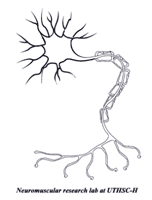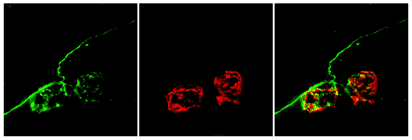Neuromuscular Research Laboratory
 Welcome to the Neuromuscular Research Laboratory in the Department of Neurology of McGovern Medical School at UTHealth. We are motivated by opportunities to improve treatments for individuals with peripheral neuropathies, and the laboratory is dedicated to discovering treatments to enhance nerve repair in patients with peripheral neuropathies.
Welcome to the Neuromuscular Research Laboratory in the Department of Neurology of McGovern Medical School at UTHealth. We are motivated by opportunities to improve treatments for individuals with peripheral neuropathies, and the laboratory is dedicated to discovering treatments to enhance nerve repair in patients with peripheral neuropathies.
Our research spans a wide range of clinical and basic topics. Our research seeks fundamental understanding of the mechanisms involved in the pathogenesis of autoimmune neuropathies and the process of axon regeneration and nerve repair. This laboratory also provides training for post-graduate scholars and for medical, graduate, and selected undergraduate students. Our personnel include diverse, independent-minded group of post-doctoral fellows, research scientists, research faculty, and staff who share space resources and a common vision. We hope that this website can provide valuable information to patients, donors, clinicians, researchers, applicants, and anyone interested in neuromuscular diseases.
Current Projects
- Pathogenesis of autoimmune neuropathies
These studies focus on understanding cellular and molecular mechanisms involved in antibody-mediated nerve injury. Our group examines the role of antibodies directed against glycosphingolipids enriched in nerve cells called gangliosides. The purpose of these studies is to identify novel targets for drug development. Both cell culture and animal models are used for these studies. This project is funded by a grant from NIH/NINDS. - Immune effectors and nerve repair
Failure of nerve cells to regenerate after injury is a complex issue. Most previous work has focused on endogenous inhibitory signals present in the injured nervous system. We have recently found that autoantibodies with clinical relevance can significantly impair peripheral nerve repair. The major goals of this project are to study the biologic effects of antibodies directed against gangliosides on nerve repair/axon regeneration. Primary neuronal cultures and animal models are used to define molecular and cellular mechanisms of antibody-mediated inhibition of nerve regeneration. We anticipate that these studies will identify novel molecular targets for the development of therapeutic strategies. This project is funded by a grant from NIH/NINDS. - Novel strategies to enhance axon regeneration and nerve repair
Development of preclinical models of delayed nerve repair in the laboratory has allowed us to examine strategies to enhance nerve repair. In this regard we have evaluated the proregenerative effects of erythropoietin (EPO) in these models. EPO is an FDA approved medication with neurotrophic properties. We are also developing modified forms of EPO for enhanced neurotrophic properties to be tested in the preclinical models used in our laboratory. These studies are funded by GBS and CIDP International Foundation. - Development of MRI technology to assess neuromuscular disorders in preclinical and clinical studies
The goal of these studies is to develop non-invasive imaging techniques for serial application to quantify nerve and muscle injury and repair in preclinical and clinical settings. This technology has the potential to be used as an outcome measure in preclinical and clinical therapeutic screening studies. These ongoing studies are performed in collaboration with Dr. Ponnada Narayana’s MRI group in Department of Radiology at UTHSC-H and are funded by NIH/NINDS.

Lab Personnel
- Kazim Sheikh, M.D., Professor of Neurology; Director, Neuromuscular Research Laboratory
- Gang Zhang, M.D., Ph.D., Associate Professor of Neurology
- Tong Gao, Ph.D., Research Scientist
Selected Publications
- Massaad, CA., Zhang, G., Pillai, L., Azhdarinia, A., Liu, W., Sheikh, K. Fluorescently-tagged anti-ganglioside antibody selectively identifies peripheral nerve in living animal. Sci Rep. 2015 Oct 30;5:15766. doi: 10.1038/srep15766
- He, L., Zhang, G., Liu, W., Gao, T., Sheikh, KA. Anti-ganglioside antibodies induce nodal and axonal injury via Fcγ receptors-mediated inflammation. J Neurosci. 2015 Apr 29;35(17):6770-85. doi: 10.1523/JNEUROSCI.4926-14.2015
- Lehmann, HC., Zhang, G., Sheikh, KA. New and emerging treatments of Guillain-Barré syndrome (2014). Expert Opinion on Orphan Drugs. 2:817-829.
- Zhang, G., Bogdanova, N., Gao, T., Song, JJ., Cragg, MS., Glennie, MJ., Sheikh, KA. Fcγ receptor-mediated inflammation inhibits axon regeneration (2014). PLoS One. 9(2):e88703. doi: 10.1371/journal.pone.0088703. eCollection 2014.
- Zhang G, Hoffman PN, Sheikh KA. Axonal degeneration in dorsal columns of spinal cord does not induce recruitment of hematogenous macrophages (2014). Exp Neurol. 252:57-62.
- Zhang, G., Lehmann, HC., Bogdanova, N., Gao, T., Zhang, J., Sheikh, KA (2011) Erythropoietin Enhances Nerve Repair in Anti-ganglioside Antibody-Mediated Models of Immune Neuropathy. PLoS One. 6(10):e27067.
- Zhang, G., Lehmann, C., Manoharan, S., Hashmi, M., Shim, S., Ming, G., Schnaar, RL., Lopez, PH., Bogdanova N., Sheikh, KA (2011) Anti-Ganglioside Antibody-Mediated Activation of RhoA Induces Inhibition of Neurite Outgrowth. J Neurosci 31(5): 1664-75.
- Lopez PH, Zhang G, Zhang J, Lehmann HC, Griffin JW, Schnaar RL, Sheikh KA (2010) Passive Transfer of IgG Anti-GM1 Antibodies Impairs Peripheral Nerve Repair. J Neurosci 30:9533-9541.
- Lehmann HC, Zhang J, Mori S, Sheikh KA(2010). Diffusion tensor imaging to assess axonal regeneration in peripheral nerves, Exp Neurol 223:238-244.
- Sheikh KA. Non-invasive imaging of nerve regeneration(2010). Exp Neurol 223:72-76.
- Zhang J, Zhang G, Morrison B, Mori S, Sheikh KA (2008) Magnetic resonance imaging of mouse skeletal muscle to measure denervation atrophy. Exp Neurol 212:448-457.
- Lopez PH, Zhang G, Bianchet MA, Schnaar RL, Sheikh KA (2008) Structural requirements of anti-GD1a antibodies determine their target specificity. Brain 131:1926-1239.
- Lehmann H, Sheikh KA. Guillain-Barre syndrome. In: Neuroimmune Pharmacology (1st edition). Ikezu T, Gendelman HE (eds.). 2008 Springer 263-281.
- Buchwald B, Zhang G, Vogt-Eisele AK, Zhang W, Ahangari R, Griffin JW, Hatt H, Toyka KV, and Sheikh KA (2007) Anti-ganglioside antibodies alter presynaptic release and calcium influx. Neurobiol Dis 28:113-121.
- Lehmann HC, Lopez PHH, Zhang G, Ngyuen T, Zhang JY, Kiesier BC, Mori S, Sheikh KA (2007) Passive immunization with anti-ganglioside antibodies directly inhibits axon regeneration in an animal model. J Neurosci 27:27-34.
- Zhang, G., Lin, J., Ghauri, S., Sheikh, KA. Modulation of IgG-FcRn interactions to overcome antibody-mediated inhibition of nerve regeneration. Acta Neuropathol. 2017 Aug;134(2):321-324. doi: 10.1007/s00401-017-1730-x. Epub 2017 May 30. PMID: 28560634
- Zhang, G., Sheikh, KA. Role of Fcγ receptor mediated inflammation in immune neuropathies. J Clin Cell Immunol. 2017 April: 8:490. doi: 10.4172/2155-9899.1000490
- Zhang, G., Massaad, CA., Gao, T., Pillai, L., Bogdanova, N., Ghauri, S., Sheikh KA. Sialylated intravenous immunoglobulin suppress anti-ganglioside antibody mediated nerve injury. Exp Neurol. 2016 Aug;282:49-55. doi:10.1016/j.expneurol.2016.05.020. Epub 2016 May 18. PMID: 27208700
- Sheikh, KA., Zhang, G. Antibody-based neuronal and axonal delivery vectors for targeted ligand delivery. Neural Regen Res. 2016 May;11(5):712-4. doi: 10.4103/1673-5374.182685. PMID:27335542